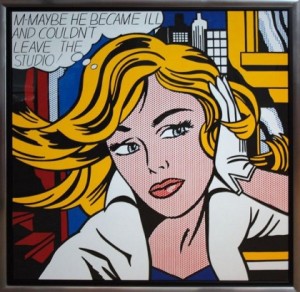Pop Art and Intellectual Propertyby Logan AlbrightNov. 25, 2014 |
Popular 
Sen. Hawley: Send National Guard to Crush Pro-Palestine Protests Like 'Eisenhower Sent the 101st to Little Rock'

AP: 'Israeli Strikes on Gaza City of Rafah Kill 22, Mostly Children, as U.S. Advances Aid Package'

Mistrial Declared in Case of Arizona Rancher Accused of Killing Migrant Trespasser

John Podhoretz Demands National Guard Be Sent Into Columbia U to Put Down Pro-Palestine Protests

House Passes $95B Foreign Aid Giveaway to Israel, Ukraine and Taiwan, Combined With TikTok Ban
  One of the most iconic painters of the 20th century was Roy Lichtenstein, a New York based artist who, alongside Andy Warhol, came to fame as one of the defining voices in the American Pop Art movement. Pop Art was based around the idea of taking popular and lowbrow images, such as those found in advertising, and transforming them into high art. Warhol famously did this by painting large scale representations of Campbell's soup cans and hanging them in galleries. It was a concept that had never really been done before and, love it or hate it, you have to admit it was unique. One of the most iconic painters of the 20th century was Roy Lichtenstein, a New York based artist who, alongside Andy Warhol, came to fame as one of the defining voices in the American Pop Art movement. Pop Art was based around the idea of taking popular and lowbrow images, such as those found in advertising, and transforming them into high art. Warhol famously did this by painting large scale representations of Campbell's soup cans and hanging them in galleries. It was a concept that had never really been done before and, love it or hate it, you have to admit it was unique.Lichtenstein's trademark was blowing up single panels from trashy pulp comics and painting them onto canvases, complete with hand drawn representations of dot-based newspaper printing process. At that point in history, comics were considered to be among the lowest of the low in terms of entertainment, pure lowest common denominator. The fact that we today revere comic book artists as true masters of their craft and shell out big bucks for rare collectors items or signed prints is thanks, in no small part, to Lichtenstein's efforts at making us reexamine the genre. One would think that the artists themselves would be grateful. Formerly, they were low paid tradesman whose work carried little prestige and zero fame. Today, Frank Miller and Alan Moore are practically household names. People preserve comics in plastic sleeves, and gather in droves each year at conventions to heap adoration upon their illustrator heroes. It would be hyperbole to give Lichtenstein full credit for this transformation, but there can be no doubt that forcing people to examine comic book art in the context of gallery presentation was a contributing factor. But gratitude is not so readily forthcoming as we might like. In a recent autobiographical comic, one of the original artists whose work Lichtenstein transformed reminisces bitterly on how he was not paid by the pop artist, nor given any credit. He seems to think that better intellectual property protection would have made him a rich man, all thanks to Lichtenstein's promotional efforts on his behalf. Not likely. Let's imagine a world in which Roy Lichtenstein would have had to pay royalty fees to the artists whose work he (more or less) copied. Does anyone think that he, as a New York artist just starting out, would have bothered to shell out the money or seek permission to do what he did? In all likelihood, he would have simply fabricated his own comic panels rather than making use of existing ones, that is, if he didn't choose a different subject for his paintings altogether. Neither of these options would have in any way benefited the original artist, who is now able to base a career on the fact that his work is famous among art lovers everywhere. Think of all the comic artists of the era who didn't receive the Lichtenstein treatment. Has anyone ever heard of them? Lichtenstein's recontextualization of existing work is not theft, nor has it harmed the original artists. It is brought their work to the masses and allowed them to achieve a level of fame they never would have on their own. People who love Lichtenstein will seek out the original source material, learn about the artists, and increase both their fame and fortune. In a world with stricter intellectual property protections, none of this would have been possible. In the eagerness to protect their work and (what they view as) their rightful profits, artists shoot themselves in the foot, limiting their exposure and stifling the creativity of others. Lichtenstein is no thief, he' was a revolutionary with wide-reaching cultural consequence. What a sad and dreary world it would be if such innovation were squashed by the overly restrictive hand of government force. _ Logan Albright is a writer and economist in Washington, DC. |



